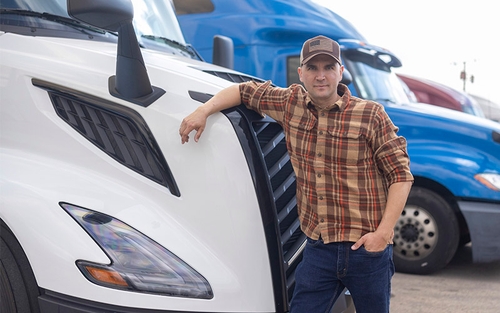How much do owner-operators make? Average revenue and more
April 19, 2024

Estimated reading time: 3 minutes
Before you start your own trucking business, it’s important to know how much revenue you may be able to generate as an owner-operator. This insight is crucial for informed decision-making and financial planning.
In this article, we’ll break down the annual revenue potential for owner-operators who do business with Schneider, based on what type of freight they haul and four pay-influencing factors.
Of course, how often the owner-operator chooses to provide services, what freight they select and a number of other factors may influence their revenue potential. In short, each owner-operator is in control of their own destiny when it comes to how much revenue their business can generate.
Owner-operator revenue
Van truckload owner-operators
Solo owner-operators who do business with Schneider have the potential to generate $180,000-$250,000 in revenue each year.
Team owner-operators who do business with Schneider have the potential to generate $320,000-$430,000 in revenue each year.
Tanker owner-operators
Tanker owner-operators who do business with Schneider have the potential to generate $190,000-$285,000 in revenue each year.
Port dray owner-operators
Drayage owner-operators who do business with Schneider have the potential to generate $150,000-$250,000 in revenue each year.
Some factors that influence how much revenue an owner-operator generates
1. How they get their loads.
How owner-operators select their loads can have a big impact on their revenue potential.
For example, if they use a broker or dispatcher, their business might lose some of the revenue on the load they haul due to the fees they must pay for these services.
On the flip side, using a public load board or leasing-on with a carrier and using their private load board would most likely not require the owner-operator to pay a commission or fee in connection with the selected shipments.
2. How they get paid.
How owner-operators get paid depends on how they choose their loads and whether they operate under their own authority or lease-on with a carrier.
Generally, there are three major ways owner-operators earn revenue from the loads they haul:
- All-in or flat rate: When owner-operators lease-on with a carrier that has its own load board, they may generate revenue for each load they haul through a flat rate. This method is similar for owner-operators who utilize brokers for their loads. At Schneider, for example, some owner-operators choose to follow this model and receive a flat rate, which is a combination of revenue and fuel surcharge.
Percent revenue of the load: Earning a percentage of revenue from each load that's hauled is another way owner-operators who do business with a carrier may be paid. At Schneider, for example, some owner-operators choose to follow this model and receive 65% of line haul revenue and 100% of fuel surcharge and accessorials on the loads they haul.
Mileage: When owner-operators get their loads from a load board, loads are usually shown as a rate per mile. These rates may vary by what load board they use, what type of freight they haul, etc.
3. What their operating expenses are.
Operating expenses have a huge impact on how much net income an owner-operator brings home. (A business’ net income – like profit – can be thought of simply as the difference between total revenue and expenses.)
There are many expenses associated with operating a semi-truck and running a business, including:
- Fuel.
- Truck payments.
A great way to determine how much an owner-operator makes after expenses is to calculate cost per mile. By adding fixed and variable costs and dividing them by how many miles were driven, an owner-operator can determine what their rate per mile needs to be to make a profit.
4. The quality of freight they haul.
One of the reasons why an owner-operator's business may not succeed is because they don’t have the right strategy when it comes to how they choose their loads.
Through trial and error, many owner-operators discover it’s not always about choosing loads with the longest length of haul. Instead, they find loads that:
- Are lighter weight (less pounds = less fuel consumed).
Pay well.
Require less travel or out-of-route miles.
- Bring them to an area with a high volume of freight.
Bring them to a desirable geographic location (picking freight over flat roads may be a better business decision as compared to freight that requires winter mountain pass driving).
It’s up to every owner-operator to figure out what loads are most profitable for their business.



